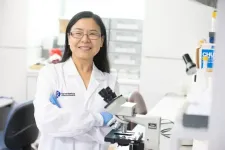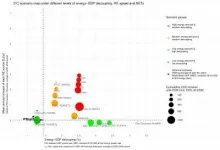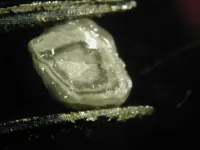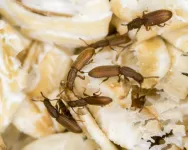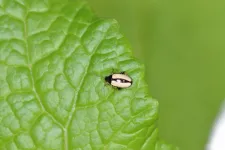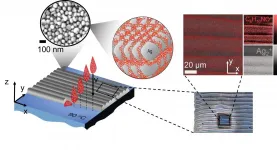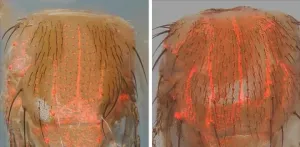INFORMATION:
This research was supported by Australia's National Health & Medical Research Council and a Diabetes Australia Research Programme grant.
Boosting body heat production: A new approach for treating obesity
2021-05-11
(Press-News.org) A receptor that helps conserve energy when food is scarce may be the key to a safer approach to treating diet-induced obesity, research led by the Garvan Institute of Medical Research has revealed.
In a study using experimental models and fat tissue biopsies from obese individuals, the team revealed that blocking a specific receptor of the molecule neuropeptide Y (NPY), which helps our body regulate its heat production, could increase fat metabolism and prevent weight gain.
"The Y1 receptor acts as a 'brake' for heat generation in the body. In our study, we found that blocking this receptor in fat tissues transformed the 'energy-storing' fat into 'energy-burning' fat, which switched on heat production and reduced weight gain," says Dr Yan-Chuan Shi, Leader of the Neuroendocrinology Group at Garvan and co-senior author of the paper published in Nature Communications.
"Most of the current medications used to treat obesity target the brain to suppress appetite and can have severe side effects that limit their use. Our study reveals an alternative approach that targets the fat tissues directly, which may potentially be a safer way to prevent and treat obesity."
Y1 receptor linked to obesity
Obesity and overweight are major public health issues, which in Australia are estimated to affect two thirds of all adults. The condition can lead to severe medical complications, including diabetes, cardiovascular disease and some cancers, and while lifestyle changes are essential to weight loss, medication is a crucial adjunct treatment option for some.
The authors of the study investigated Y1 receptors controlled by the molecule NPY, which is released in the body under conditions of starvation to help reduce energy expenditure and increase fat storage. Surprisingly, the team discovered that Y1 receptors were produced at higher levels in the fat tissue of obese individuals.
The team then blocked the Y1 receptor using the experimental treatment BIBO3304 in a mouse model of obesity.
"In our study, we found that mice that were administered BIBO3304 and fed a high-fat diet gained about 40% less body weight over seven weeks than mice on a high-fat diet alone. This significant reduction of body weight gain was caused by an increase in body heat generation and reduction in fat mass," says Dr Shi.
"Further, when we applied BIBO3304 to human fat cells isolated from obese individuals, we found that the cells began switching on the same genes involved in producing heat as the ones in mice, which suggests that targeting the Y1 receptor pathway may similarly increase fat metabolism and reduce weight gain in humans," Dr Shi adds.
Targeting obesity at the source
"NPY is a metabolism regulator that plays a critical role during states of low energy supply, where it helps store fat as a survival mechanism. Today however, these advantageous effects can exacerbate existing diet-induced weight gain, leading to obesity and metabolic disease," says co-senior author Professor Herbert Herzog, Head of the Eating Disorders Lab at Garvan.
The researchers say a crucial component of the study was to demonstrate that the experimental treatment BIBO3304 did not cross the blood brain barrier, and that the anti-obesity effects of blocking the Y1 receptor pathways occurred not via the brain, but specifically only in peripheral tissues.
"Most current prescribed treatments are aimed at reducing food intake by targeting the central nervous system. However, these can have significant psychiatric or cardiovascular side effects, which have resulted in over 80% of these medications being withdrawn from the market," says Dr Shi.
"Our study is crucial evidence that blocking Y1 receptors in peripheral tissues without affecting the central nervous system is effective at preventing obesity by increasing energy expenditure. It reveals a new therapeutic approach that is potentially safer than current medications that target appetite," says Professor Herzog.
"Our team and other groups have revealed further potential benefits in targeting the NPY-Y1 receptor system, including the stimulation of bone cell growth, and improvement in cardiovascular function and insulin resistance," he adds. "We hope that the publication of our findings will lead to increased interest for exploring BIBO3304 and related agents as potential treatments for obesity and other health conditions."
ELSE PRESS RELEASES FROM THIS DATE:
1.5°C degrowth scenarios suggest need for new mitigation pathways: Research
2021-05-11
The first comprehensive comparison of 'degrowth' scenarios with established pathways to limit climate change highlights the risk of over-reliance on carbon dioxide removal, renewable energy and energy efficiency to support continued global growth - which is assumed in established global climate modelling.
Degrowth focuses on the global North and is defined as an equitable, democratic reduction in energy and material use while maintaining wellbeing. A decline in GDP is accepted as a likely outcome of this transition.
The new modelling by the University of Sydney and ETH Zürich includes high growth/technological change and scenarios summarised ...
Hidden within African diamonds, a billion-plus years of deep-earth history
2021-05-11
Diamonds are sometimes described as messengers from the deep earth; scientists study them closely for insights into the otherwise inaccessible depths from which they come. But the messages are often hard to read. Now, a team has come up with a way to solve two longstanding puzzles: the ages of individual fluid-bearing diamonds, and the chemistry of their parent material. The research has allowed them to sketch out geologic events going back more than a billion years--a potential breakthrough not only in the study of diamonds, but of planetary evolution.
Gem-quality diamonds are nearly pure lattices of carbon. This elemental purity ...
A beetle's Achilles heel
2021-05-11
Saw-toothed grain beetles live in a symbiotic association with bacteria. Their bacterial partners provide important building blocks for the formation of the insect's exoskeleton, which protects the beetles from their enemies as well as from desiccation. In a new study, a team of scientists from the Johannes Gutenberg University in Mainz, the Max Planck Institute for Chemical Ecology in Jena, and the National Institute of Advanced Industrial Science and Technology in Japan demonstrates that glyphosate inhibits the symbiotic bacteria of the grain beetle. Beetles exposed to the weedkiller no longer receive the building blocks they need from the bacteria. The study shows that glyphosate has the potential to harm insects indirectly by targeting their bacterial partners ...
Horseradish flea beetle: Protected with the weapons of its food plant
2021-05-11
When horseradish flea beetles feed on their host plants, they take up not only nutrients but also mustard oil glucosides, the characteristic defense compounds of horseradish and other brassicaceous plants. Using these mustard oil glucosides, the beetles turn themselves into a "mustard oil bomb" and so deter predators. A team of researchers from the Max Planck Institute for Chemical Ecology in Jena, Germany, has now been able to demonstrate how the beetle regulates the accumulation of mustard oil glucosides in its body. The beetles have special transporters in the excretory system that prevent the excretion of mustard ...
Stabilizer residue in inks found to inhibit conductivity in 3D printed electronic
2021-05-11
Inks containing metal nanoparticles are among the most commonly-used conductive materials for printed electronics. Ink-jetting layers of MNP materials allows for unpreceded design flexibility, rapid processing and 3D printing of functional electronic devices such as sensors, solar panels, LED displays, transistors and smart textiles.
Inkjet 3D printing of metals typically form a solid printed object via a two-step process: solvent evaporation upon printing (pinning) and subsequent low-temperature consolidation of nanoparticles (sintering). The low temperature is important as in many applications the nanoparticles are co-printed with ...
New genetic copycatchers detect efficient and precise CRISPR editing in a living organism
2021-05-11
Researchers at the University of California San Diego have laid the groundwork for a potential new type of gene therapy using novel CRISPR-based techniques.
Working in fruit flies and human cells, research led by UC San Diego Postdoctoral Scholar Zhiqian Li in Division of Biological Sciences Professor Ethan Bier's laboratory demonstrates that new DNA repair mechanisms could be designed to address the effects of debilitating diseases and damaged cell conditions.
The scientists developed a novel genetic sensor called a "CopyCatcher," which capitalizes on CRISPR-based gene drive technology, to detect instances in which a genetic element is copied precisely from one chromosome to another throughout cells in ...
Sex cells in parasites are doing their own thing
2021-05-11
Researchers at the University of Bristol have discovered how microbes responsible for human African sleeping sickness produce sex cells.
In these single-celled parasites, known as trypanosomes, each reproductive cell splits off in turn from the parental germline cell, which is responsible for passing on genes. Conventional germline cells divide twice to produce all four sex cells - or gametes - simultaneously. In humans four sperms are produced from a single germline cell. So, these strange parasite cells are doing their own thing rather than sticking to ...
Study shows how our brains sync hearing with vision
2021-05-11
Every high-school physics student learns that sound and light travel at very different speeds. If the brain did not account for this difference, it would be much harder for us to tell where sounds came from, and how they are related to what we see.
Instead, the brain allows us to make better sense of our world by playing tricks, so that a visual and a sound created at the same time are perceived as synchronous, even though they reach the brain and are processed by neural circuits at different speeds.
One of the brain's tricks is temporal recalibration: ...
Low temperature physics gives insight into turbulence
2021-05-11
A novel technique for studying vortices in quantum fluids has been developed by Lancaster physicists.
Andrew Guthrie, Sergey Kafanov, Theo Noble, Yuri Pashkin, George Pickett and Viktor Tsepelin, in collaboration with scientists from Moscow State University, used tiny mechanical resonators to detect individual quantum vortices in superfluid helium.
Their work is published in the current volume of Nature Communications.
This research into quantum turbulence is simpler than turbulence in the real world, which is observed in everyday phenomena such as surf, fast flowing rivers, billowing storm clouds, or chimney smoke. Despite ...
Inhibition of proteins activated by nitric oxide reverses aortic aneurysm in Marfan syndrome
2021-05-11
Scientists at the Centro Nacional de Investigaciones Cardiovasculares Centro de Biología Molecular Severo Ochoa (CBM-CSIC-UAM) have discovered that the nitric oxide (NO) pathway is overactivated in the aortas of mice and patients with Marfan Syndrome and that the activity of this pathway causes the aortic aneurysms that characterize this disease.
The results of the study, published today in Nature Communications, reveal the essential role played by NO in Marfan Syndrome aortic disease and identify new therapeutic targets and markers of NO pathway activation that could be used to monitor disease status and progression.
Aortic aneurysm ...
